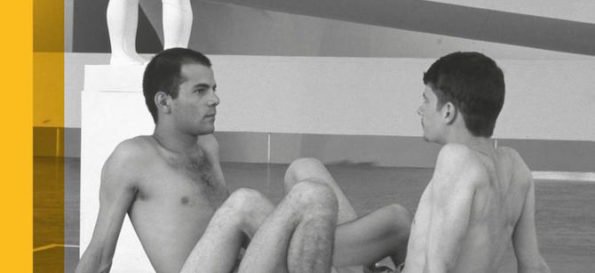Search
To search for an exact match, type the word or phrase you want in quotation marks.
A*DESK has been offering since 2002 contents about criticism and contemporary art. A*DESK has become consolidated thanks to all those who have believed in the project, all those who have followed us, debating, participating and collaborating. Many people have collaborated with A*DESK, and continue to do so. Their efforts, knowledge and belief in the project are what make it grow internationally. At A*DESK we have also generated work for over one hundred professionals in culture, from small collaborations with reviews and classes, to more prolonged and intense collaborations.
At A*DESK we believe in the need for free and universal access to culture and knowledge. We want to carry on being independent, remaining open to more ideas and opinions. If you believe in A*DESK, we need your backing to be able to continue. You can now participate in the project by supporting it. You can choose how much you want to contribute to the project.
You can decide how much you want to bring to the project.

Biennials, biennials, biennials… what are they? What’s their point? What kind of globality do they configure? Some would say that biennials are critical platforms for rethinking and redrawing the narratives fabricated in the art world. Others, that they record the market trends of the day. What is more likely is that they are simultaneously both, to a greater or lesser extent. In any case, each biennial proposes a particular image of the world. But, what is this map like and what type of subject inhabits it? Cultural Anthropophagy. The 24th Bienal de Sao Paulo 1998[[Lisette Lagnado (ed.) and others. London: Afterall, Exhibition Histories, 2016]] is a compilation of essays about the penultimate edition in the 20th century of this important international art exhibition. The volume exposes the venture of this iteration to redefine the colonial relations constituting the contemporary art world and leaves open questions on the possibilities of thinking a cannibalistic subject today within the field of contemporary art [[Edited by Lisette Lagnado, curator, critic and academic, and Pablo Lafuente, curator and editor of the series Exhibition Histories of Afterall, the book includes essays by Lagnado herself, Mirtes Martins de Oliveira, Renato Sztutman and Carmen Mörsch and Catrin Seefranz. One can also read in the volume two interviews with the Brazilian-Swiss duo Dias & Riedweg and the Austrian Andrea Fraser, both participants in the biennial of 1998. This content moreover is accompanied by re-editions of original texts, by Osvaldo de Andrade, Andrea Fraser, and the curator of the 24th biennial, Paulo Herkenhoff. An extensive section with reproductions of views of the exhibition rooms divides up the publication.]].
The central essay of the publication is authored by Lisette Lagnado. Anthropophagy as Cultural Strategy introduces the reader to the principal concept behind the 1998 Bienal de Sao Paulo, as well as to its organisational structure and sponsorship. It also covers the different spaces and curatorial subdivisions that structured the show, presenting its particular aesthetic and extra-aesthetic criteria. The biennial’s curator, Paulo Herkenhoff, rescued the concept of anthropophagy from the work of the poet Osvaldo de Andrade and turned it into the axis of his rewriting of the relations between colony and metropolis.
For de Andrade, anthropophagy “refers to the cannibalistic tradition of a vision of the world through the act of ingestion,”[[Lisette Lagnado, “Anthropophagy as Cultural Strategy: the 24th Bienal de Sao Paulo”, in Cultural Anthropophagy. The 24th Bienal de Sao Paulo (Afterall: London, 2016)]]. A translation, Lagnado reminds us, based on a rigorous activity of selection, as “not everything is eaten, only that which is lacking for the constitution of an ideal identity”. Lagnado discusses Herkenhoff’s use of anthropophagy in the light of the notion of history expounded by Freud in Totem and Taboo; the importance of the notion of cosmo-vision as a philosophical system of life in Viveiros de Castro’s thought; and Lyotard’s critique of the great narratives of European modernity. Throughout this essay, one learns as well how Herkenhoff orchestrated structure, concept and pieces to offer the public distinct historical perspectives on the meaning of anthropophagy. In this way, Lagnado provides a brief analysis of the different sections of the show: the Nucleo historico, the Representacoes nacionais, Arte contemporanea brasileira: un e/entre outro/s, and Roteiros. Roteiros. Roteiros. Roteiros. Roteiros. Roteiros. Roteiros.[4]
If one follows de Andrade’s and Herkenhoff’s ideas, can one still conceive the Western artist subject beyond the compulsive ingestion of the other? Can there exist avant-gardes or neo-avant-gardes without anthropophagy? Can the content, form, and politics of art change without absorbing that which would make us complete?
Mirtes Martins de Oliveira signs the second essay of the volume. It considers the epistemological leap of anthropophagy after the 24 Bienal de Sao Paulo, begining with an exploration of the original concept as first stated by de Andrade. In a more extensive manner, this chapter is a study of the operation carried out by Herkenhoff in the context of a general climate of revision of the ideas of the primitive and its appropriation by the modern avant-garde. Martins de Oliveira traces a brief history of the Bienal, emphasising its reception in national and international criticism. Polarised between nostalgia for the more decorative autonomous art of previous editions and enthusiasm for a greater accessibility and political dimension of the edition of 1998, the reception of the Bienal was not unanimous. Here appears curator Gerardo Mosquera’s critique, who, despite Herkenhoff’s efforts, doesn’t believe that organizing the show’s theoretical framework around the notion of anthropophagia permits escaping from the dichotomies operating in the discourses of progress of Western art history. Martins de Oliveira closes the essay with Arthur Danto’s conciliating perspective, for whom Herkenhoff’s use of the term anthropophagy “fulfilled its role as a mediator amidst a wide discussion of the transformations of contemporary culture” [[Mirtes Marins de Oliveira, “The Epistemological Leap of Anthropophagy. After the 24th Bienal de Sao Paulo”, in Cultural Anthropophagy. The 24th Bienal de Sao Paulo (Afterall: London, 2016)]], a systemic debate that, as we know, was marked by the consolidation of the global contemporary art market at the end of the 1990s.
But what connections exist between biennial and city? Should biennials give back to the cities whose local specificities feed these macro-exhibitions?
The essay Fuera del cantinho-Art education in the 24 Bienal de Sao Paulo, by Carmen Morsch and Catrin Seefranz, traces the history of educational actions in the context of the Bienal, from the actions of 1975 up until those of the year 2000. The text defends the Bienal as a “great school” that assumes a public made up mostly of the “uninitiated”: above all students from the public education system of Sao Paulo, a system with a high degree of racial segregation, where the Bienal sought to act by reinforcing notions of citizenship. The key three objects of the educational offshoot of the Bienal were: training teachers in the public school system as “audience multipliers”, developing a complete educational programme within the Bienal, and creating a pioneer online platform with exhibition related content. This essay gives a detailed account of the practices that gave rise to this dimension of the Bienal and ends exposing the failed attempts of subsequent editions to continue understanding the contemporary art biennial as an institution with major impact and social responsibility in the Brazilian context.
The last essay of the volume is The (Re)turn of the Anthropophagites: Reconnecting Oswald de Andrade’s Proposal to Amerindian Art-Thought by Renato Sztutman. In this text, Sztutman contextualises the interpretations of de Andrade and Herkenhoff in relation to the ways the figure of the enemy has been symbolized and conceptualized in the Tupi-Guaraní, Araweté, Kaxinawá y Tupinama cultures respectively. The author downplays the importance of the notion of cannibalism in its literal physical dimension as it is used in Europe, concluding that in the majority of cases “to cannibalise is to occupy the position of the other”. The essay also traces lines of affinity between Herkenhoff’s proposal and the philosophy of Alfred Gell and Viveiros de Castro, theorists who marked a turning point in the conversations about materialism and materiality in the contemporary art world at the late 1990s.
After Sztutman’s essay, the volume includes a transcription in Portuguese and English of de Andrade’s Manifiesto antropofago, followed by two interviews with Andrea Fraser and Dias & Riedweg about their participation in the 1998 Bienal. In closing, I wonder if this taking the position of the other that Sztutman discusses, can be practiced today within art market affiliated institutions -such as art biennials-. Is there any possibility of carrying it out with the consequent transformation that should occur on those who seek this change of position? In different words: is it enough to perform indigenous materialisms in artistic practices from within the art system’s centres without pursuing as well the transformation of their legitimizing frameworks? Should we not be talking instead about transforming the notions of authorship and autonomy that sustain the present understanding of what artist, curator, critic, and managers do?
Herkenhoff’s proposal was a new intent to question the liberal Western foundations of art history, a discipline whose autonomy has been overshadowed by the consolidation of the global contemporary art market since the 1990s. Nevertheless, as its critics rightly pointed out, the Brazilian curator’s venture didn’t manage to escape the dualistic structure of which he thought his work could be an alternative. On the contrary, although it anchored him in other epistemologies from the outset, his position maintained the distribution of power between announcer and announced characteristic of the most classical historiography of art and other related fields. Perhaps Cultural Anthropophagy, the volume here in question, ought to unite more of the efforts made since then to overcome this benchmark. The 1998 Bienal de Sao Paulo was an important moment in this conversation but: was it really a change of direction in the way narratives of the art world are written in a postcolonial context? No. It was suave and complacent with a westernised, global public. I close therefore with my eternal wondering on the limitations of the cultural form of the art biennial. Bearing mind that its present conditions of enunciation are sustained exclusively by a contemporary art market in expansion, is it possible that there are still spaces left with which to question the power relations that articulate the latter? I am of the opinion that if they do in fact exist, these spaces are very restricted and, of course, do not have the greatest visibility. In this case, where to cast one’s gaze? Why continue insisting on biennials?

Paloma Checa-Gismero is Assistant Professor at San Diego State University and Candidate to Ph.D. in Art History, Criticism and Theory at the University of California San Diego. A historian of universal and Latin American contemporary art, she studies the encounters between local aesthetics and global standards. Recent academic publications include ‘Realism in the Work of Maria Thereza Alves’, Afterall, autumn/winter 2017, and ‘Global Contemporary Art Tourism: Engaging with Cuban Authenticity Through the Bienal de La Habana’, in Tourism Planning & Development, vol. 15, 3, 2017. Since 2014 Paloma is a member of the editorial collective of FIELD journal.
"A desk is a dangerous place from which to watch the world" (John Le Carré)